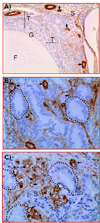Contrast-enhanced sonography depicts spontaneous ovarian cancer at early stages in a preclinical animal model
- PMID: 21357555
- PMCID: PMC3105598
- DOI: 10.7863/jum.2011.30.3.333
Contrast-enhanced sonography depicts spontaneous ovarian cancer at early stages in a preclinical animal model
Abstract
Objective: Our goal was to examine the feasibility of using laying hens, a preclinical model of human spontaneous ovarian cancer, in determining the kinetics of an ultrasound contrast agent indicative of ovarian tumor-associated neoangiogenesis in early-stage ovarian cancer.
Methods: Three-year-old White Leghorn laying hens with decreased ovarian function were scanned before and after intravenous injection of a human serum albumin-perflutren contrast agent at a dose of 5 μL/kg body weight. Gray scale morphologic characteristics, Doppler indices, the arrival time, peak intensity, and wash-out of the contrast agent were recorded and archived on still images and video clips. Hens were euthanized thereafter; sonographic predictions were compared at gross examination; and ovarian tissues were collected. Archived clips were analyzed to determine contrast parameters and Doppler intensities of vessels. A time-intensity curve per hen was drawn, and the area under the curve was derived. Tumor types and the density of ovarian microvessels were determined by histologic examination and immunohistochemistry and compared to sonographic predictions.
Results: The contrast agent significantly (P < .05) enhanced the visualization of microvessels, which was confirmed by immunohistochemistry. Contrast parameters, including the time of wash-out and area under the curve, were significantly different (P < .05) between ovaries of normal hens and hens with ovarian cancer and correctly detected cancer at earlier stages than the time of peak intensity.
Conclusions: The laying hen may be a useful animal model for determining ovarian tumor-associated vascular kinetics diagnostic of early-stage ovarian cancer using a contrast agent. This model may also be useful for testing the efficacy of different contrast agents in a preclinical setting.
Figures






Similar articles
-
VEGFR2-Targeted Ultrasound Imaging Agent Enhances the Detection of Ovarian Tumors at Early Stage in Laying Hens, a Preclinical Model of Spontaneous Ovarian Cancer.Ultrason Imaging. 2015 Jul;37(3):224-37. doi: 10.1177/0161734614553603. Epub 2014 Oct 6. Ultrason Imaging. 2015. PMID: 25294846
-
Detection of tumor-associated neoangiogenesis by Doppler ultrasonography during early-stage ovarian cancer in laying hens: a preclinical model of human spontaneous ovarian cancer.J Ultrasound Med. 2010 Feb;29(2):173-82. doi: 10.7863/jum.2010.29.2.173. J Ultrasound Med. 2010. PMID: 20103787 Free PMC article.
-
Enhancement of Ovarian Tumor Detection by DR6-Targeted Ultrasound Imaging Agents in Laying Hen Model of Spontaneous Ovarian Cancer.Int J Gynecol Cancer. 2016 Oct;26(8):1375-85. doi: 10.1097/IGC.0000000000000784. Int J Gynecol Cancer. 2016. PMID: 27465898
-
Ovarian Cancer: Applications of Chickens to Humans.Annu Rev Anim Biosci. 2022 Feb 15;10:241-257. doi: 10.1146/annurev-animal-021419-084001. Annu Rev Anim Biosci. 2022. PMID: 35167319 Review.
-
The EFSUMB Guidelines and Recommendations on the Clinical Practice of Contrast Enhanced Ultrasound (CEUS): update 2011 on non-hepatic applications.Ultraschall Med. 2012 Feb;33(1):33-59. doi: 10.1055/s-0031-1281676. Epub 2011 Aug 26. Ultraschall Med. 2012. PMID: 21874631 No abstract available.
Cited by
-
Expression of death receptor 6 by ovarian tumors in laying hens, a preclinical model of spontaneous ovarian cancer.Transl Oncol. 2012 Aug;5(4):260-8. doi: 10.1593/tlo.12184. Epub 2012 Aug 1. Transl Oncol. 2012. PMID: 22937178 Free PMC article.
-
The hen as a model of ovarian cancer.Nat Rev Cancer. 2013 Jun;13(6):432-6. doi: 10.1038/nrc3535. Epub 2013 May 16. Nat Rev Cancer. 2013. PMID: 23676850
-
Immune cells in the normal ovary and spontaneous ovarian tumors in the laying hen (Gallus domesticus) model of human ovarian cancer.PLoS One. 2013 Sep 9;8(9):e74147. doi: 10.1371/journal.pone.0074147. eCollection 2013. PLoS One. 2013. PMID: 24040191 Free PMC article.
-
Interleukin 16- (IL-16-) Targeted Ultrasound Imaging Agent Improves Detection of Ovarian Tumors in Laying Hens, a Preclinical Model of Spontaneous Ovarian Cancer.Biomed Res Int. 2015;2015:567459. doi: 10.1155/2015/567459. Epub 2015 Jun 16. Biomed Res Int. 2015. PMID: 26161406 Free PMC article.
-
GyneScan: an improved online paradigm for screening of ovarian cancer via tissue characterization.Technol Cancer Res Treat. 2014 Dec;13(6):529-39. doi: 10.7785/tcrtexpress.2013.600273. Epub 2013 Dec 6. Technol Cancer Res Treat. 2014. PMID: 24325128 Free PMC article.
References
-
- Folkman J. What is the evidence that tumors are angiogenesis dependent? J Natl Cancer Inst. 1990;82:4–6. - PubMed
-
- Shubik P. Vascularization of tumors: a review. J Cancer Res Clin Oncol. 1982;103:211–226. - PubMed
-
- Ramakrishnan S, Subramanian IV, Yokoyama Y, Geller M. Angiogenesis in normal and neoplastic ovaries. Angiogenesis. 2005;8:169–182. - PubMed
-
- Jemal A, Siegel R, Ward E, Hao Y, Xu J, Thun MJ. Cancer statistics, 2009. CA Cancer J Clin. 2009;59:225–249. - PubMed
Publication types
MeSH terms
Substances
Grants and funding
LinkOut - more resources
Full Text Sources
Other Literature Sources
Medical

